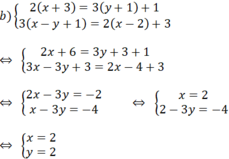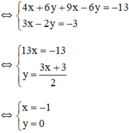giải hệ phương trình{2x+3y=3+a;x+2y=a
tìm a để x^2+y^2=17
a) giải hệ phương trình {x+y=3 {2x-3y=1 b) giải phương trình x^ -7x +10=0
\(a,\left\{{}\begin{matrix}x+y=3\\2x-3y=1\end{matrix}\right.\\ \Leftrightarrow\left\{{}\begin{matrix}2x+2y=6\\2x-3y=1\end{matrix}\right.\\ \Leftrightarrow\left\{{}\begin{matrix}5y=5\\2x-3y=1\end{matrix}\right.\\ \Leftrightarrow\left\{{}\begin{matrix}y=1\\2x-3.1=1\end{matrix}\right.\\ \Leftrightarrow\left\{{}\begin{matrix}x=2\\y=1\end{matrix}\right.\)
Vậy \(\left(x;y\right)=\left(2;1\right)\)
b, \(x^2-7x+10=0\\ \Leftrightarrow x^2-5x-2x+10=0\\ \Leftrightarrow x\left(x-5\right)-2\left(x-5\right)=0\\ \Leftrightarrow\left(x-2\right)\left(x-5\right)=0\\ \Leftrightarrow\left[{}\begin{matrix}x-2=0\\x-5=0\end{matrix}\right.\\ \Leftrightarrow\left[{}\begin{matrix}x=2\\x=5\end{matrix}\right.\)
\(a,\)\(\left\{{}\begin{matrix}x+y=3\\2x-3y=1\end{matrix}\right.\)
\(\Leftrightarrow\left\{{}\begin{matrix}3x+3y=9\\2x-3y=1\end{matrix}\right.\)
\(\Leftrightarrow\left\{{}\begin{matrix}5x=10\\2x-3y=1\end{matrix}\right.\)
\(\Leftrightarrow\left\{{}\begin{matrix}x=2\\2.2-3y=1\end{matrix}\right.\)
\(\Leftrightarrow\left\{{}\begin{matrix}x=2\\y=1\end{matrix}\right.\)
Vậy hệ pt có nghiệm duy nhất \(\left(x;y\right)=\left(2;1\right)\)
\(b,x^2-7x+10=0\)
\(\Delta=b^2-4ac=\left(-7\right)^2-4.10=9>0\)
\(\Rightarrow\) Pt có 2 nghiệm \(x_1,x_2\)
Ta có :
\(\left\{{}\begin{matrix}x_1=\dfrac{-b+\sqrt{\Delta}}{2a}=\dfrac{7+3}{2}=5\\x_2=\dfrac{-b-\sqrt{\Delta}}{2a}=\dfrac{7-3}{2}=2\end{matrix}\right.\)
Vậy \(S=\left\{5;2\right\}\)
Giải hệ phương trình 2 x - 3 y = 1 x + 2 y = 3
 (Nhân cả hai vế phương trình thứ hai với 2)
(Nhân cả hai vế phương trình thứ hai với 2)
 (Lấy phương trình thứ hai trừ đi phương trình thứ nhất).
(Lấy phương trình thứ hai trừ đi phương trình thứ nhất).

Vậy hệ phương trình có nghiệm 
Giải hệ phương trình {2x - y = -3 ,x + 3y = 2
\(\left\{{}\begin{matrix}2x-y=-3\left(1\right)\\x+3y=2\left(2\right)\end{matrix}\right.\)
Nhân \(3\) vào 2 vế của pt \(\left(1\right):-6x+3y=9\left(3\right)\)
Lấy \(\left(3\right)-\left(2\right):\)
\(-7x=7\)
\(\Leftrightarrow x=-1\)
Thay \(x=-1\) vào \(\left(1\right):2.\left(-1\right)-y=-3\)
\(\Rightarrow y=1\)
Vậy hệ pt có nghiệm duy nhất \(\left(x;y\right)=\left(-1;1\right)\)
a, rút gọn biểu thức: A= \(\sqrt{12}-\sqrt{27}+\sqrt{4+2\sqrt{3}}\)
b, giải phương trình: x2-2x-4=0
c, giải hệ phương trình: \(\left\{{}\begin{matrix}2x-y=5\\x+3y=-1\end{matrix}\right.\)
????
xin lỗi nha !
mình mới học lớp 3
mà bài này khó nắm
a.A=\(\sqrt{12}-\sqrt{27}+\sqrt{4+2\sqrt{3}}\)\(=2\sqrt{3}-3\sqrt{3}+\sqrt{\left(\sqrt{3}+1\right)^2}\) \(=-\sqrt{3}+\sqrt{3}+1\) =1 b. \(x^2-2x-4=0\) Δ= \(\left(-2\right)^2-4\times1\times-4=20>0\) \(\Rightarrow\) phương trình có 2 nghiệm pb \(x1=\dfrac{2+\sqrt{20}}{2}=1+\sqrt{5}\) \(x2=\dfrac{2-\sqrt{20}}{2}=1-\sqrt{5}\) c. \(\left\{{}\begin{matrix}2x-y=5\\x+3y=-1\end{matrix}\right.\Leftrightarrow\left\{{}\begin{matrix}2x-y=5\\2x+6y=-2\end{matrix}\right.\Leftrightarrow\left\{{}\begin{matrix}-7y=7\\2x-y=5\end{matrix}\right.\Leftrightarrow\left\{{}\begin{matrix}y=-1\\2x+1=5\end{matrix}\right.\)\(\Leftrightarrow\left\{{}\begin{matrix}y=-1\\x=2\end{matrix}\right.\)
Giải các hệ phương trình sau:
b) 2 x + 3 = 3 y + 1 + 1 3 x - y + 1 = 2 x - 2 + 3

Vậy hệ phương trình đã cho có nghiệm (x; y) =(2; 2).
Giải các hệ phương trình sau bằng phương pháp cộng đại số: 2 x + 3 y = - 2 3 x - 2 y = - 3

(Nhân hai vế pt 1 với 2, pt 2 với 3 để hệ số của y đối nhau)
 (Hệ số của y đối nhau nên cộng từng vế hai phương trình).
(Hệ số của y đối nhau nên cộng từng vế hai phương trình).

Vậy hệ phương trình có nghiệm duy nhất (-1; 0).
`2x+5y=11(1)`
`2x-3y=0(2)`
Lấy (1) trừ (2)
`=>8y=11`
`<=>y=11/8`
`<=>x=(3y)/2=33/16`
a) Ta có: \(\left\{{}\begin{matrix}2x+5y=11\\2x-3y=0\end{matrix}\right.\)
\(\Leftrightarrow\left\{{}\begin{matrix}8y=11\\2x-3y=0\end{matrix}\right.\Leftrightarrow\left\{{}\begin{matrix}y=\dfrac{11}{8}\\2x=3y=3\cdot\dfrac{11}{8}=\dfrac{33}{8}\end{matrix}\right.\)
\(\Leftrightarrow\left\{{}\begin{matrix}x=\dfrac{33}{16}\\y=\dfrac{11}{8}\end{matrix}\right.\)
Vậy: Hệ phương trình có nghiệm duy nhất là \(\left\{{}\begin{matrix}x=\dfrac{33}{16}\\y=\dfrac{11}{8}\end{matrix}\right.\)
b) Ta có: \(\left\{{}\begin{matrix}4x+3y=6\\2x+y=4\end{matrix}\right.\)
\(\Leftrightarrow\left\{{}\begin{matrix}4x+3y=6\\4x+2y=8\end{matrix}\right.\Leftrightarrow\left\{{}\begin{matrix}y=-2\\2x+y=4\end{matrix}\right.\)
\(\Leftrightarrow\left\{{}\begin{matrix}2x-2=4\\y=-2\end{matrix}\right.\Leftrightarrow\left\{{}\begin{matrix}2x=6\\y=-2\end{matrix}\right.\Leftrightarrow\left\{{}\begin{matrix}x=3\\y=-2\end{matrix}\right.\)
Vậy: Hệ phương trình có nghiệm duy nhất là (x,y)=(3;-2)
`b)4x+3y=6(1)`
`2x+y=4<=>4x+2y=8(2)`
Lấy (1) trừ (2) ta có:
`y=-2`
`<=>x=(4-2y)/2=3`
Bài tập 1 Cho hệ phương trình {mx-2y=-1
{2x+3y=1 (1)
1. Giải hệ phương trình (1) khi m = 3 .
2. Tìm m để hệ phương trình có nghiệm x =- \(\dfrac{1}{2}\) và y =\(\dfrac{2}{3}\) ![]() .
.
3. Tìm nghiệm của hệ phương trình (1) theo m.
1: Khi m=3 thì hệ phương trình (1) trở thành:
\(\left\{{}\begin{matrix}3x-2y=-1\\2x+3y=1\end{matrix}\right.\Leftrightarrow\left\{{}\begin{matrix}x=-\dfrac{1}{13}\\y=\dfrac{5}{13}\end{matrix}\right.\)
2: Khi x=-1/2 và y=2/3 vào hệ phương trình, ta được:
\(\left\{{}\begin{matrix}2\cdot\dfrac{-1}{2}+3\cdot\dfrac{2}{3}=1\\-\dfrac{1}{2}m-\dfrac{4}{3}=-1\end{matrix}\right.\Leftrightarrow m\cdot\dfrac{-1}{2}=\dfrac{1}{3}\)
hay m=-2/3
giải các hệ phương trình
9x-6y=4 và 3(4x-3y)=-3x+y+7
3(x+1)+2y=-x và 5(x+y)=-3x+y-5
2(2x+3y)=3(2x-3y)+10 và 4x-3y=4(6y-2x)+3